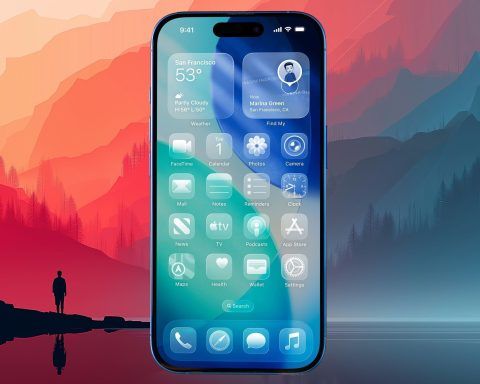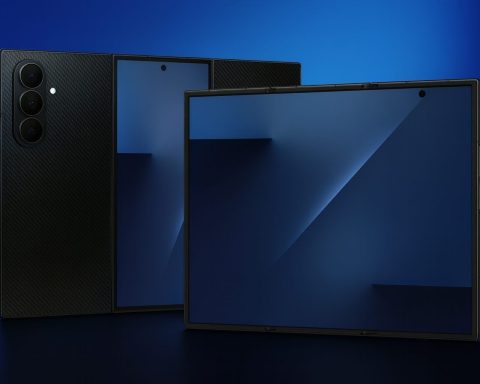- A leaked internal document claims the iPhone 17 lineup will offer 15 color options across four models (Standard, iPhone 17 Air, Pro, Pro Max), with an orange/copper finish exclusive to Pro and Pro Max, and the unveiling is expected in roughly two months.
- Apple plans to release the iOS 26 public beta in late July, around July 23, to test the redesigned Liquid Glass UI ahead of the fall release.
- Rumors indicate Apple is developing a foldable iPhone for late 2026 that could start around $1,800–$2,000 and unfold to about 4.8 mm thick, with Samsung supplying a crease-free display.
- Samsung unveiled the Galaxy Z Fold 7 and Galaxy Z Flip 7 at Galaxy Unpacked in New York, with Fold 7 26% thinner and about 10% lighter than Fold 6 and a starting price of $1,999, while the Flip 7 FE is priced at $899.
- Industry chatter points to a tri-fold Galaxy Z TriFold, code-named Project Q7M, entering mass production by year-end with a 9.96-inch unfolded display, Snapdragon 8 Elite, a silicon-carbon battery, and 8K video support.
- Google announced an August 20, 2025 event to reveal the Pixel 10 lineup—Pixel 10, Pixel 10 Pro, Pixel 10 Pro XL, and Pixel 10 Pro Fold—powered by Tensor G5 on a 3nm process and potentially featuring an IP68-rated Fold.
- OnePlus announced Plus Mind on July 15, bringing an on-device AI assistant to the OnePlus 13 and 13R via OxygenOS 15, including three-finger screen capture and a Mind Space app with AI Translation, AI Search, AI Reframe, and AI Perfect Shot.
- Redmi’s Redmi 15C leak suggests a base price of €133.90 for 4GB/128GB and about €154.90 for 256GB, a 6.9-inch 120Hz HD+ LCD, 6,000 mAh battery with 33W charging, and a 50 MP dual rear camera plus a 13 MP front camera, running Android 15 with HyperOS.
- Huawei reportedly reclaimed the top spot in China’s Q2 2025 smartphone market with 18.1% share and about 12.5 million shipments, while Apple fell to fifth with 9.6 million shipments and 13.9% share.
- The Nothing Phone (3) launches at $799, features a 6.67-inch 120Hz AMOLED display at 2800×1260, four 50 MP cameras, a 50 MP front camera, a Glyph Matrix rear display, a 5,150 mAh battery with 65W charging, and five years of major Android updates.
Apple: iPhone 17 Rumors and iOS Updates
Apple’s next iPhone is already generating buzz with leaked details about the upcoming iPhone 17 lineup. A supposedly “internal document” obtained by Macworld (and reported via MacRumors) claims to reveal all 15 color options for the iPhone 17 series – including a new orange/copper finish exclusive to the Pro and Pro Max models [1]. With the official iPhone 17 unveiling expected in roughly two months, leaks are firming up many aspects of the four-model lineup (standard, 17 Air, Pro, Pro Max) [2], suggesting Apple will offer its broadest palette of iPhone colors in years.
Meanwhile, Apple is preparing the next big software release. The iOS 26 public beta (the upcoming iPhone OS, renumbered after WWDC) is slated to drop in late July – Bloomberg’s Mark Gurman reports the public beta should arrive “on or around Wednesday, July 23” [3]. This will let adventurous users test new features and a major redesign of the iOS interface ahead of the full fall release. (Apple unveiled iOS 26’s revamped design and “Liquid Glass” UI theme at WWDC in June, marking one of the biggest iOS overhauls in years.)
Apple is also cracking down on leaks: it filed a lawsuit this week against YouTuber Jon Prosser, accusing him of misappropriating trade secrets by revealing early iOS 26 details [4]. Prosser had posted rendered previews of iOS 26’s new design (back when everyone assumed it would be called “iOS 19”), and while not every detail was spot on, Apple is making an example of the leak as it seeks to protect its secrets. On the innovation front, fresh reports are shedding light on Apple’s long-rumored foldable iPhone. The device – expected in late 2026 – could start around $1,800–$2,000 and measure roughly 4.8 mm thin when unfolded, if rumors hold true [5]. Notably, Apple is said to be sourcing a “crease-free” folding display from Samsung for this project [6], the same advanced OLED tech likely to appear in Samsung’s own Galaxy Z Fold8 next year. In short, Apple is laying groundwork (in both software and hardware) for big changes – from new colors and UIs this year to entirely new form-factors in the future.
Samsung: Foldable Launches, AI Features & Tri-Fold Ambitions
Samsung had a big week in mobile. At its Galaxy Unpacked event in New York, the company unveiled the Galaxy Z Fold 7 and Galaxy Z Flip 7, pushing foldable phones to be sleeker and smarter. The Fold 7 is significantly slimmed down – 26% thinner and about 10% lighter than its predecessor Fold 6 [7] – yet packed with top-end specs. It runs on Qualcomm’s latest Snapdragon 8 Elite chipset for blazing performance [8]. Samsung did nudge the price up (~5% higher than last year): the Fold 7 now starts at $1,999 in the U.S. [9]. Meanwhile, the Flip 7 clamshell got a surprise Fan Edition: a new Galaxy Z Flip 7 FE priced at $899 to make foldables more accessible [10]. (The standard Flip 7 remains in the lineup as a premium model, rumored around the $999 mark, while the FE trades a few high-end components for that lower price.) Both devices boast refined hinges and AI enhancements in One UI 8 – part of Samsung’s effort to integrate smart features into everything from the camera to battery management.
Samsung’s leadership emphasized how AI and foldables are core to its strategy. “I believe that foldable phones, integrated with AI features, are ready to become mainstream by offering a unique, differentiated experience,” said Samsung Mobile president Choi Won-joon in an interview [11]. He noted that making foldables smarter – e.g. using AI to optimize the user experience – is key to pushing them beyond a niche. Samsung’s approach to AI also involves partnerships; Choi pointed out Samsung is working closely with Google on AI services, a contrast to Apple’s more insular strategy [12]. In fact, Samsung even introduced its first wearables with built-in Google AI at Unpacked: new Galaxy smartwatches featuring Google’s “Gemini” AI voice assistant, which can proactively suggest things like ideal running routes for the user [13]. All of this underscores Samsung’s plan to lead in AI-powered devices as a differentiator. It’s an important move, as competition is heating up – Chinese rivals Huawei and Honor are rapidly cutting into Samsung’s foldable market share, especially in China [14]. (Foldables are still a premium niche globally, accounting for only ~1.5% of smartphones [15], but they’re a lucrative niche attracting many players.)
Looking ahead, Samsung is already teasing the next leap: tri-fold phones. At a press conference after the launch, mobile chief TM Roh confirmed Samsung is “working towards launching a tri-foldable phone by the end of the year.” [16] This would be a phone that folds in three parts, a concept Samsung showed off in a January demo. Industry leaks suggest it will likely be called the “Galaxy Z TriFold,” folding in a zig-zag “G” shape, and could have a huge 9.96-inch display when fully opened [17] [18]. (For perspective, that’s tablet-sized – nearly 10 inches of screen.) The tri-fold, code-named Project Q7M, is reportedly entering mass production but may see only a limited release initially [19]. It’s expected to use a Snapdragon 8 Elite chip and a new silicon-carbon battery for power [20], plus a triple-camera setup and support for 8K video. In essence, Samsung wants to leapfrog competitors in the foldable race – which now includes not just Huawei’s top-end Mate X series but even concept devices from up-and-comers like Tecno (who recently showed off a Phantom Ultimate G Fold tri-fold concept) [21]. We’ll likely hear more by October if the leaks are right on the launch timing [22].
Samsung isn’t neglecting more traditional smartphones either. In India, Samsung launched the Galaxy F36 5G on July 19 – a budget-friendly phone that still packs some punch [23]. Priced under ₹20,000 (~$250), the Galaxy F36 offers a 50 MP main camera with OIS, a roomy 6.5-inch display, and Samsung’s own Exynos 1380 chip [24]. Notably, it runs Android 15 with the new One UI 7, bringing some of Samsung’s latest AI-powered software features to a lower-cost device [25]. The F36 sports a trendy vegan-leather design and comes in vibrant colors (red/orange, black, purple) [26], showing Samsung’s effort to entice style-conscious budget buyers. It’s available via Flipkart, reflecting how India’s smartphone market remains key for Samsung’s midrange strategy. On the software front, Samsung also began rolling out its July 2025 security patches to several Galaxy models (including the Galaxy S21 FE and others) [27], part of the company’s ongoing commitment to monthly updates. All told, Samsung’s week spanned ultra-premium foldables to affordable 5G phones, with a common thread of AI features and refined designs aiming to keep Samsung on top in an increasingly crowded race.
Google: Pixel 10 Teased and Android Updates
Google is gearing up for its next flagship launch. The company announced a “Made by Google” event for August 20, 2025 – just a few weeks away – where it will unveil the Pixel 10 series [28]. According to insiders, Google plans an ambitious four-device lineup this year: a Pixel 10, Pixel 10 Pro, Pixel 10 Pro XL, and a new Pixel 10 Pro Fold [29]. The Fold will be Google’s second-gen folding phone (following 2024’s Pixel Fold) and is expected to be the star of the show. Rumors suggest the Pixel 10 Pro Fold will prioritize durability and water-resistance – it might not be quite as thin and light as Samsung’s Galaxy Fold7, but it could boast an IP68 rating for full water/dust proofing, which would actually one-up Samsung’s Fold7 (rated IPx8/IP5X) [30]. If true, that means Google may deliver the first truly waterproof foldable phone on the market, a notable feat for durability. Other upgrades sound more incremental: the Pixel Fold’s inner display may get slightly larger and brighter, and battery capacity will improve a bit [31].
Under the hood, all Pixel 10 models will run on Google’s new Tensor G5 chip, fabricated on a 3nm process by TSMC [32]. This custom chipset should bring a healthy performance and efficiency boost over last year’s G4 (which had faced some thermal and battery critiques). Design-wise, don’t expect a radical overhaul – the Pixel 10 and 10 Pro/XL are rumored to closely resemble the Pixel 9 series in appearance and size [33]. Google seems to be focusing its changes on internals and software. In particular, we’re likely to see new AI-driven features announced alongside these phones. Google is reportedly baking more AI smarts into the Pixel experience – for instance, enhanced AI photo editing tools (building on Magic Eraser and Photo Unblur) are expected to debut with the Pixel 10 lineup [34]. Given Google’s I/O conference earlier in May already introduced AI in everything from Gmail to Android, it’s a safe bet the Pixel event will highlight how AI makes the Pixel 10’s camera and software experience “smarter” than ever.
In current Pixel news, Google’s July software update took an unexpected turn – Verizon accidentally leaked the Pixel phones’ July 2025 update before Google’s official announcement [35]. A support page on Verizon’s site briefly went live, revealing the changelog for the Pixel’s July security patch. According to the leak, this month’s update is a relatively small but targeted one: it fixes a Wi-Fi stability issue that had been plaguing some users, and it resolves some “visual experience” glitches with Android Auto in-car displays [36]. In other words, no new features – just two important bug fixes that should improve day-to-day connectivity and usability. (Pixel owners had reported sporadic Wi-Fi drops and odd UI bugs in Android Auto, so these patches will be welcome.) The Verizon page was quickly pulled down, suggesting it went up a bit early; nevertheless, Pixel fans now know what to expect when the July update officially lands (usually Google pushes Pixel OTAs by the first week of the month, though it can vary).
It’s worth noting this comes on the heels of a bigger update: Android 16 was recently rolled out to Pixel devices a few weeks ago as Google’s latest OS upgrade. That launch wasn’t entirely smooth – some Pixel users have complained of unresponsive gestures and buttons after the Android 16 upgrade [37]. Google will be hoping these monthly patches iron out such kinks. With Android 16 now in the wild and Pixel hardware on the horizon, Google’s clearly in the thick of its annual refresh cycle. And if the rumor mill is accurate, August 20 will not only bring new Pixel phones but possibly a Pixel Watch 4 and other hardware – truly setting the stage for Google’s clash with Apple’s iPhone 17 in the fall.
OnePlus: New AI Features & Software Upgrades
OnePlus is rolling out a major software update focused on artificial intelligence and quality-of-life features. In a July 15 announcement, OnePlus detailed its new “Plus Mind” feature – an AI-powered digital assistant – coming to the OnePlus 13 series phones [38] [39]. Plus Mind debuted earlier this year on the OnePlus 13T/13s, but will now arrive on the standard OnePlus 13 and 13R models via an OxygenOS 15 update (rolling out “over the coming weeks” globally) [40] [41]. So what does Plus Mind do? Think of it as a smart memory and organizer for everything you view on your phone. With a simple three-finger swipe-up gesture, OnePlus 13 users will be able to instantly capture whatever is on their screen – a webpage, image, message, you name it – and have the AI analyze and extract key information [42]. For example, swipe up on an event flyer and Plus Mind will recognize the details (date, time, location) and prompt you to add a calendar event, while saving the event info in a special “Mind Space” app for later reference [43]. If you swipe up on, say, a product page or a news article, the AI can generate a summary or pull out the important bits of info [44]. It’s like having a context-aware notepad that’s always on hand – aimed at helping users “remember everything” and reduce information overload.
“OnePlus AI is all about helping you work smart and play harder… Plus Mind has been specifically developed to act as a personal intelligence for our users, helping them remember everything in a secure and private way,” said Arthur Lam, OnePlus’s Director of OxygenOS and AI Strategy [45].
Under the hood, OnePlus says all this happens on-device to maintain privacy. The new “Mind Space” app will index the content you save and even make it searchable with natural language via OnePlus’s AI Assistant. Alongside Plus Mind, the OxygenOS 15 update is bringing a suite of other AI enhancements to OnePlus 13 phones. These include:
- AI Translation: a unified translator that handles text, voice, camera translation etc. in one app (useful for travel or multilingual users) [46].
- AI Search: an upgraded search bar that understands natural language queries to find things on your phone (files, settings, notes) – basically supercharging the phone’s search with AI smarts [47].
- AI Reframe: an AI photography tool that analyzes your photos and suggests improved crop/framing options by identifying the subject and optimal composition [48].
- AI Perfect Shot: a clever feature for group photos – it can detect if someone blinked or looked away and automatically swap in faces from a burst of photos to create one “perfect” group shot where everyone looks their best [49].
All these features were developed under OnePlus’s “personalized intelligence” initiative, which involved gathering feedback from users about their hopes and concerns with AI. Notably, OnePlus is implementing these AI features across different regions stepwise – some debuted first in China, others in India or North America – but the company is now unifying them in this global update. It’s a bold attempt to differentiate OxygenOS from other Android experiences by leaning into AI. Combined with the OnePlus 13’s already strong hardware (the flagship has been praised for its performance and build quality [50]), these new features might make the OnePlus 13 series feel “smarter” than your average smartphone. If you own a OnePlus 13 or 13R, keep an eye out for the OxygenOS build (v15.0.840 and up) hitting your device soon – it could transform how you use your phone’s everyday functions.
Xiaomi & Redmi: Budget Phone Leak Packs a Punch
Xiaomi’s sub-brand Redmi is about to release a new ultra-budget handset, and leaks suggest it will offer exceptional specs for the price. Early retail listings in Europe have revealed details of the Redmi 15C, an entry-level Android phone that hasn’t been officially announced yet [51]. Here are the key takeaways from the leak:
- Ultra-Low Price: The Redmi 15C was spotted on an Italian retailer’s site at just €133.90 for the base 4GB RAM + 128GB storage model (and around €154.90 for a 256GB variant) [52]. That budget pricing makes it one of the most affordable smartphones in Xiaomi’s lineup, aiming squarely at value-conscious buyers.
- Big Display (120Hz!): Despite the price, the Redmi 15C isn’t skimping on the screen. It reportedly features a large 6.9-inch HD+ LCD display with a 120Hz refresh rate [53] – a surprisingly high refresh rate at this price point. The design images show a modest waterdrop notch for the selfie camera and fairly slim bezels, giving it a modern look for a budget phone.
- Huge Battery & Decent Camera: Redmi is known for big batteries, and the 15C is no exception: it packs a massive 6,000 mAh battery with support for 33W fast charging, which should easily provide multi-day battery life on a single charge [54]. Camera-wise, it’s said to have a 50 MP dual rear camera (likely a wide + depth sensor) and a 13 MP front camera [55]. While not multi-lens extravagance, a 50MP primary shooter at this price could produce solid shots in good lighting.
- Hardware & Software: Powering the device is a MediaTek Helio G81 chipset [56] – a capable entry-level octa-core chip, sufficient for everyday tasks (browsing, messaging, light gaming) though not meant for heavy gaming. It will reportedly run Android 15 out of the box with Xiaomi’s latest HyperOS interface on top [57]. (HyperOS is Xiaomi’s newer software, succeeding MIUI, aiming for a cleaner, faster experience.) Impressively for a budget phone, the Redmi 15C includes nice extras like a side-mounted fingerprint scanner, NFC support for payments, and an IP64 rating for dust and splash resistance [58] – features often absent in this class.
If this leak holds true, the Redmi 15C could be one of the best bang-for-buck phones in late 2025, offering a huge high-refresh display and huge battery for barely over $150. Xiaomi has been aggressive in the budget segment, especially in markets like India and Europe, and the 15C seems poised to continue that strategy. We expect Xiaomi to formally announce the Redmi 15C soon (possibly alongside other Redmi 15 series models). Budget smartphone shoppers should definitely keep an eye out – this device shows that cheap doesn’t have to mean compromised. As one report put it, the 15C’s leaked specs “seem too good to be true” – yet Xiaomi has a track record of delivering strong specs at rock-bottom prices [59].
Huawei & Market Trends: Huawei’s Comeback and Smartphone Slowdown
In broader industry news, Huawei has reclaimed the top spot in China’s smartphone market – a milestone in the company’s comeback from sanctions and supply challenges. According to new Q2 2025 data from IDC, Huawei captured 18.1% of China’s smartphone market in the April–June quarter, making it the #1 vendor in China for the first time in over four years [60]. Huawei shipped about 12.5 million phones in China during Q2, which is a 3.4% decline year-on-year [61] – but importantly, its decline was smaller than rivals’, allowing it to overtake them. It’s a remarkable rebound driven by strong demand for Huawei’s latest devices (which notably include models with revived 5G capabilities and new in-house Kirin chips to circumvent U.S. restrictions).
Apple, by contrast, has slipped to fifth place in China’s market. Apple’s iPhone shipments in China were 9.6 million units in Q2 – down 1.3% year-on-year [62]. Thanks to price cuts and government subsidy programs on the iPhone 16 series, Apple’s decline was relatively mild (and its market share actually ticked up to 13.9%) [63]. But the Cupertino company is well off the pace in China right now, especially compared to Huawei. In fact, Apple has now seen eight consecutive quarters of year-over-year decline in China [64], reflecting both economic headwinds and fierce local competition. Xiaomi (the #4 vendor) was the only top-five brand to grow shipments in China during Q2 [65], leveraging its strong budget and midrange lineup. Vivo and OPPO remained significant (holding #2 and #3 spots respectively), but they suffered drops in sales (Vivo’s volume fell a steep 10% YoY) [66]. Overall, China’s smartphone shipments fell ~4% in Q2 compared to a year ago [67], breaking a brief recovery streak seen over the past year.
Analysts say the dip is largely due to consumer demand softening amid economic uncertainty. “The broader economic environment presents ongoing challenges, with consumer confidence remaining subdued,” noted Arthur Guo, a senior research analyst at IDC, adding that a significant uplift in smartphone demand is unlikely in the immediate term [68]. In other words, many Chinese consumers are holding onto phones longer and being more price-conscious, which is impacting sales of high-end models in particular. This trend isn’t confined to China – globally, smartphone sales have been relatively flat and even the excitement around foldable phones hasn’t translated into mass-market adoption yet. Foldables remain a tiny niche (~1.5% of total smartphone shipments), partly due to their high prices and still-evolving use cases [69].
That said, the premium segment is where brands seek profits and Huawei’s resurgence is telling. Huawei’s return to 18% share in China – largely at the expense of OPPO, Vivo, and even Honor – shows the pent-up demand for its devices after years of sanctions-limited supply [70]. Honor (spun off from Huawei in 2020) had briefly filled the void and is also competing hard, particularly with foldables and stylish mid-tiers. But now Huawei’s latest flagships (like the Mate 60 series) are proving extremely popular in China, even as they lack Google services globally. This home-market strength has vaulted Huawei back to relevance. It also means Samsung will face even stiffer competition in foldables: Huawei’s flagship Mate XT is currently the world’s only tri-folding phone on sale (a super-premium device upwards of $2,500), and a Mate XT2 is rumored for September [71]. Additionally, Honor and Xiaomi have their own foldable models targeting various price points. Samsung still dominates global foldable share, but Canalys forecasts Samsung’s foldable sales will be flat or slightly down in 2025, as Chinese makers expand their offerings [72]. In short, the smartphone market in mid-2025 is a mixed picture: China’s slowing down overall, but local champions like Huawei are rising again – and the battle for high-end customers (whether for iPhone vs. Huawei in China or Samsung vs. everyone in foldables) is intensifying.
Other Noteworthy Launches: Nothing, Motorola, and More
Several emerging and niche smartphone brands also made waves recently with new launches and innovations:
Nothing Phone (3) – A Flagship with a Funky Twist: London-based startup Nothing (led by OnePlus co-founder Carl Pei) officially launched the Phone (3) earlier this month to considerable fanfare [73]. This is Nothing’s first true flagship-class phone and it shows in the specs – and price. The Phone 3 starts at $799 / €799 for a 12GB RAM + 256GB model [74], putting it in upper-midrange territory, and packs a 6.67-inch 120Hz AMOLED display (at a sharp 2800×1260 resolution) plus a custom-tuned Snapdragon 8 s Gen 4 chipset [75]. It’s also one of the brightest phone screens out, hitting up to 4500 nits peak brightness for outdoor visibility [76]. Nothing didn’t skimp on other hardware either: you get a hefty 5,150 mAh battery (even larger 5,500 mAh on units sold in India) with 65W fast charging and 15W wireless charging support [77]. Notably, the Phone 3 ships with Android 15-based Nothing OS 3.5 and the company is committing to 5 years of major Android updates (and 7 years of security patches) – a longer support window than even Google offers [78]. This should give buyers confidence that Nothing plans to stick around in the premium segment.
What truly sets the Phone (3) apart, however, is its quirky design and UI features. Nothing replaced the flashy LED light strips of its previous models with a new “Glyph Matrix” display on the back of the phone [79]. This is a tiny monochrome dot-matrix screen embedded in the rear glass, which can show pixelated images, icons, or scrolling text. In practical use, the Glyph Matrix lights up to display things like the time, notifications (with customizable icons/emojis), and even mini-apps or games. For example, Nothing created a retro Magic 8-Ball app and a “Spin the Bottle” toy that play out on the back display, purely for fun [80] [81]. The Glyph interface also has user-programmable “widgets” – the community has tools to design their own pixel art or mini functions for it. It’s a bold, playful take on smartphone notifications intended to let you check info “at a glance” without turning on the main screen (potentially reducing screen time) [82]. Of course, Nothing also paid attention to core features: the Phone 3 comes with a powerful quad-camera setup totaling four 50 MP sensors [83]. This includes a 50MP main camera (with OIS), a 50MP 3× telephoto (that doubles for macro shots), a 50MP ultra-wide, and even a 50MP front camera – an almost unheard-of resolution for selfies [84]. All four cameras can record 4K video at 60 fps, showcasing Nothing’s focus on imaging. Early hands-on reports praise the build quality and the novelty of the Glyph Matrix, though we’ll see how it holds up in real-world use. Overall, the Nothing Phone (3) is injecting some much-needed whimsy and competition into the smartphone scene, proving that even a small brand can innovate on design while still delivering flagship-grade performance.
Motorola Razr 2025 – Retro Flip, Modern AI: Not to be outdone in the cool factor department, Motorola has refreshed its iconic razr flip phone, and it’s leveraging both nostalgia and AI. The new motorola razr 2025 (sometimes called Razr+ 2025 in marketing) became available in the U.S. through carriers in mid-July [85]. Physically, it’s a classic foldable flip phone: when closed, there’s a 3.6-inch OLED “Quick View” display on the outside for notifications, selfies, and quick apps [86]. Flip it open and you get a 6.9-inch pOLED internal screen – about the size of a regular smartphone, but in a tall 22:9 aspect ratio [87]. Motorola has improved the hinge and durability further from the 2024 edition, but the big focus this year is on AI-driven features. The razr comes with Motorola’s custom “moto AI” software built-in, which the company says delivers “15% improved AI performance” over the previous model [88]. In practical terms, moto AI acts as a personal assistant layer: it can proactively remind you of tasks, help snap better photos, and learn your usage patterns to streamline your day [89]. For example, Motorola touts tools like Image Studio, which uses AI to touch up photos and even generate creative shots, and smart organization features that learn what info you frequently need [90]. The AI also helps with power management – ensuring that despite the phone’s relatively small battery (a common flip phone trade-off), it lasts all day by intelligently managing background activity.
Motorola is pushing the razr 2025 with aggressive pricing (in the US, new customers can get it for $99 on a carrier plan with Boost Mobile [91] [92]) to lure users into trying a foldable. The razr’s combination of pocket-friendly design + AI smarts + a bit of nostalgia is unique in the market. And it’s not just a fashion phone: it has upper-midrange specs (Snapdragon 7-series chipset, dual cameras, etc.) comparable to a solid mainstream phone – meaning users aren’t sacrificing capability. With the razr 2025, Motorola joins Samsung and others in integrating AI voice assistants and predictive features into new models, reflecting a broader industry trend. Even as smartphone sales globally are lukewarm, devices like the razr show manufacturers experimenting with form factors and intelligent features to spark consumer interest. Whether it’s Motorola’s AI-enhanced flip phone, Nothing’s glyph-light flagship, or Tecno’s concept triple-foldable, 2025 is proving to be an exciting year for mobile tech – and the news from July 19–20 is a reminder that innovation is alive and well across the smartphone industry.
Sources:
- MacRumors – “Top Stories: iPhone 17 Colors, iOS 26 Public Beta Incoming, and More” [93] [94]; “Apple Sues Jon Prosser Over iOS 26 Leaks” [95]; “All 15 New iPhone 17 and iPhone 17 Pro Colors Revealed in Latest Leak” [96]; “Foldable iPhone’s Thickness and Price Range Detailed in New Reports” [97]
- Reuters – Samsung Unpacked coverage: “Samsung to fend off Chinese foldable phone rivals with slimmer model” [98] [99]; Market analysis: “China smartphone market reverses to decline in Q2… Huawei reclaimed top spot” [100] [101]; Foldables niche data [102]
- Gadgets360 – “Samsung’s Launch Timeline for First Tri-Fold Smartphone Leaked” [103] [104] (Galaxy Z TriFold rumor, Ice Universe and Max Jambor leaks)
- Moneycontrol – “Samsung Galaxy F36 5G launching today, July 19, 2025” (India launch details) [105] [106]
- Android Headlines – “Verizon Leaks Google Pixel’s July 2025 Update: Here’s What It Includes” [107] [108]
- MacRumors – “Google to Unveil New Pixel 10 Smartphones on August 20” [109] [110] (Pixel 10 series and Fold details)
- 9to5Google – “OnePlus 13 will get its AI-powered ‘Plus Mind’ update” [111] [112]; (press release) [113] [114]
- GizChina – “Redmi 15C official details leak: price, specs, and features revealed” [115] [116]
- Reuters – “China smartphone market… Huawei reclaimed top spot” [117] [118]; “Huawei’s market share and Apple’s decline” [119] [120]
- Reuters – “Samsung’s foldable shipments flat; foldables 1.5% of market; Honor/Huawei competition” [121] [122]
- 9to5Google – “Nothing Phone (3) goes official with ‘Glyph Matrix’ for $799” [123] [124]
- Boost Mobile Press Release via PRNewswire – “motorola razr 2025… lasts longer and is smarter” [125] [126]; “razr 2025 available for $99.99 on Boost” [127] [128]
References
1. www.macrumors.com, 2. www.macrumors.com, 3. www.macrumors.com, 4. www.macrumors.com, 5. www.macrumors.com, 6. www.macrumors.com, 7. www.reuters.com, 8. www.reuters.com, 9. www.reuters.com, 10. www.reuters.com, 11. www.reuters.com, 12. www.reuters.com, 13. www.reuters.com, 14. www.reuters.com, 15. www.reuters.com, 16. www.reuters.com, 17. www.gadgets360.com, 18. www.gadgets360.com, 19. www.gadgets360.com, 20. www.gadgets360.com, 21. www.gadgets360.com, 22. www.gadgets360.com, 23. www.moneycontrol.com, 24. www.moneycontrol.com, 25. www.moneycontrol.com, 26. www.moneycontrol.com, 27. www.gizchina.com, 28. www.macrumors.com, 29. www.macrumors.com, 30. www.macrumors.com, 31. www.macrumors.com, 32. www.macrumors.com, 33. www.macrumors.com, 34. www.macrumors.com, 35. www.androidheadlines.com, 36. www.androidheadlines.com, 37. www.androidheadlines.com, 38. 9to5google.com, 39. 9to5google.com, 40. 9to5google.com, 41. 9to5google.com, 42. 9to5google.com, 43. 9to5google.com, 44. 9to5google.com, 45. 9to5google.com, 46. 9to5google.com, 47. 9to5google.com, 48. 9to5google.com, 49. 9to5google.com, 50. 9to5google.com, 51. www.gizchina.com, 52. www.gizchina.com, 53. www.gizchina.com, 54. www.gizchina.com, 55. www.gizchina.com, 56. www.gizchina.com, 57. www.gizchina.com, 58. www.gizchina.com, 59. www.gizchina.com, 60. www.reuters.com, 61. www.reuters.com, 62. www.reuters.com, 63. www.reuters.com, 64. www.reuters.com, 65. www.reuters.com, 66. www.reuters.com, 67. www.reuters.com, 68. www.reuters.com, 69. www.reuters.com, 70. www.reuters.com, 71. www.gadgets360.com, 72. www.reuters.com, 73. 9to5google.com, 74. 9to5google.com, 75. 9to5google.com, 76. 9to5google.com, 77. 9to5google.com, 78. 9to5google.com, 79. 9to5google.com, 80. 9to5google.com, 81. 9to5google.com, 82. 9to5google.com, 83. 9to5google.com, 84. 9to5google.com, 85. about.dish.com, 86. about.dish.com, 87. about.dish.com, 88. about.dish.com, 89. about.dish.com, 90. about.dish.com, 91. about.dish.com, 92. about.dish.com, 93. www.macrumors.com, 94. www.macrumors.com, 95. www.macrumors.com, 96. www.macrumors.com, 97. www.macrumors.com, 98. www.reuters.com, 99. www.reuters.com, 100. www.reuters.com, 101. www.reuters.com, 102. www.reuters.com, 103. www.gadgets360.com, 104. www.gadgets360.com, 105. www.moneycontrol.com, 106. www.moneycontrol.com, 107. www.androidheadlines.com, 108. www.androidheadlines.com, 109. www.macrumors.com, 110. www.macrumors.com, 111. 9to5google.com, 112. 9to5google.com, 113. 9to5google.com, 114. 9to5google.com, 115. www.gizchina.com, 116. www.gizchina.com, 117. www.reuters.com, 118. www.reuters.com, 119. www.reuters.com, 120. www.reuters.com, 121. www.reuters.com, 122. www.reuters.com, 123. 9to5google.com, 124. 9to5google.com, 125. about.dish.com, 126. about.dish.com, 127. about.dish.com, 128. about.dish.com










